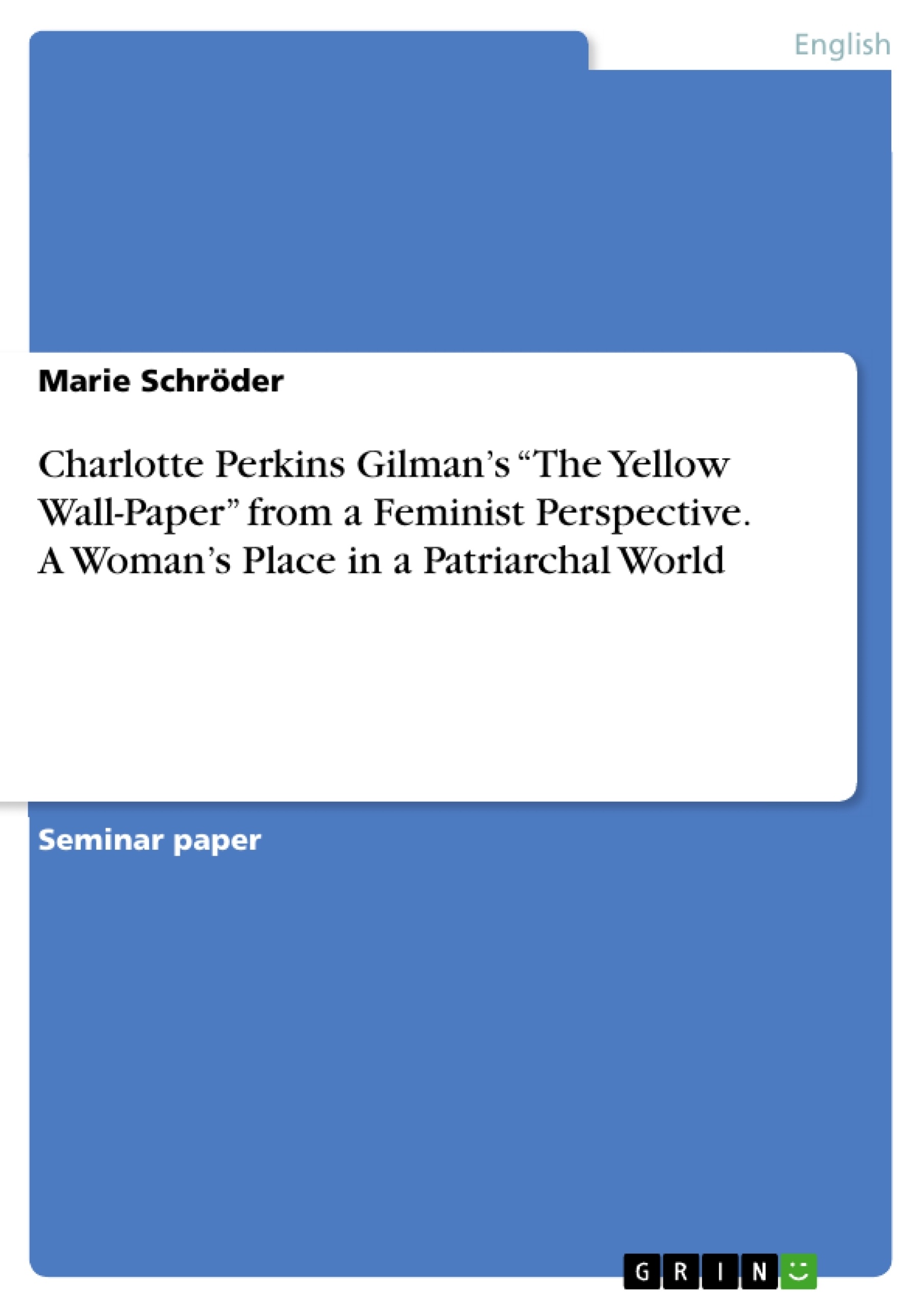“The Yellow Wallpaper” gives ample scope for interpretation, and therefore a great amount of (sometimes conflicting) readings emerged since its publication. As this term paper attempts to reveal the way Gilman criticizes the suppression of women in her days, the discussion will mainly include the analytical work of feminist critics.
For the inquiry, the following questions will be central:
1) How does Gilman use language to criticize the patriarchal structures presented in the story?
2) In which way can the heroine’s behavior and progress be interpreted as a reflection of the rising feminist activism?
3) To what extend does the image of the woman in the wallpaper convey meaning?
Table of Contents
- 1. Introduction
- 2. Historical Background
- 2.1 A man's world: Gender rights in the 19th Century America
- 2.2 Feminist Activism and the "New Woman"
- 2.3 Charlotte Perkins Gilman: Life and work
- 3. "The Yellow Wallpaper" and its feminist criticism
- 3.1 Victorian Ideals and Patriarchal structures
- 3.2 The Protagonist's writing and her reading of the Wallpaper: The rising of the "New Woman"?
- 4. Conclusion
Objectives and Key Themes
This paper examines Charlotte Perkins Gilman's "The Yellow Wallpaper" through a feminist lens, analyzing how Gilman critiques the patriarchal structures of 19th-century America and reflects the rise of feminist activism. The analysis focuses on Gilman's use of language, the protagonist's behavior, and the symbolism within the story.
- The portrayal of gender inequality and patriarchal structures in 19th-century America.
- The depiction of the "New Woman" and the rise of feminist activism.
- Gilman's use of language and symbolism to critique societal norms.
- The protagonist's descent into madness as a representation of societal constraints on women.
- The interpretation of the wallpaper as a metaphor for women's oppression.
Chapter Summaries
1. Introduction: This chapter introduces Charlotte Perkins Gilman's "The Yellow Wallpaper" and its significance as a feminist text. It establishes the central research questions guiding the analysis, focusing on Gilman's critique of patriarchal structures, the reflection of rising feminist activism in the protagonist's journey, and the symbolic meaning of the wallpaper. The chapter sets the stage for a deeper exploration of the story's themes and their historical context.
2. Historical Background: This section provides crucial context for understanding "The Yellow Wallpaper." It first explores the legal and social realities of women in 19th-century America, highlighting their limited rights and the prevailing ideology of "separate spheres." The chapter then shifts to discuss the burgeoning feminist activism and the emergence of the "New Woman," contrasting the restrictive Victorian ideals with the growing challenges to traditional gender roles. This historical overview forms a solid foundation for interpreting the story's themes of oppression and resistance.
Keywords
Feminist criticism, Charlotte Perkins Gilman, "The Yellow Wallpaper," 19th-century America, gender inequality, patriarchal structures, Victorian ideals, New Woman, feminist activism, symbolism, literary analysis.
Frequently Asked Questions: Charlotte Perkins Gilman's "The Yellow Wallpaper" - A Feminist Analysis
What is the purpose of this document?
This document provides a comprehensive preview of a paper analyzing Charlotte Perkins Gilman's "The Yellow Wallpaper" through a feminist lens. It includes a table of contents, objectives and key themes, chapter summaries, and keywords.
What are the main themes explored in the analysis of "The Yellow Wallpaper"?
The analysis focuses on several key themes: the portrayal of gender inequality and patriarchal structures in 19th-century America; the depiction of the "New Woman" and the rise of feminist activism; Gilman's use of language and symbolism to critique societal norms; the protagonist's descent into madness as a representation of societal constraints on women; and the interpretation of the wallpaper as a metaphor for women's oppression.
What is covered in the "Historical Background" section?
This section provides crucial historical context, exploring the legal and social realities of women in 19th-century America, highlighting their limited rights and the prevailing ideology of "separate spheres." It also discusses the burgeoning feminist activism and the emergence of the "New Woman," contrasting restrictive Victorian ideals with the growing challenges to traditional gender roles.
What is the focus of the analysis of "The Yellow Wallpaper" itself?
The analysis examines how Gilman critiques the patriarchal structures of 19th-century America and reflects the rise of feminist activism within the story. It focuses on Gilman's use of language, the protagonist's behavior, and the symbolism within the story.
What are the key chapters and their respective summaries?
The paper is structured as follows: Chapter 1 (Introduction): Introduces the story and its significance as a feminist text, establishing the central research questions. Chapter 2 (Historical Background): Provides crucial historical context regarding women's rights and the rise of feminist activism in 19th-century America. Chapter 3 ("The Yellow Wallpaper" and its feminist criticism): Analyzes the story itself through a feminist lens. Chapter 4 (Conclusion): Summarizes the findings.
What keywords are associated with this analysis?
Key words include: Feminist criticism, Charlotte Perkins Gilman, "The Yellow Wallpaper," 19th-century America, gender inequality, patriarchal structures, Victorian ideals, New Woman, feminist activism, symbolism, literary analysis.
What is the overall objective of the paper?
The paper aims to examine "The Yellow Wallpaper" through a feminist lens, analyzing how Gilman critiques patriarchal structures and reflects the rise of feminist activism. It seeks to interpret the story's symbolism and its portrayal of women's experiences within a restrictive societal context.
- Quote paper
- Marie Schröder (Author), 2015, Charlotte Perkins Gilman’s “The Yellow Wall-Paper” from a Feminist Perspective. A Woman’s Place in a Patriarchal World, Munich, GRIN Verlag, https://www.hausarbeiten.de/document/343783


